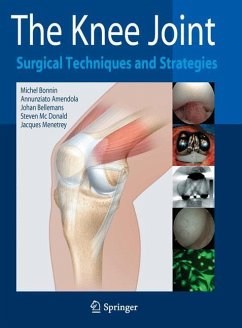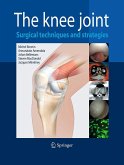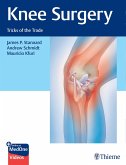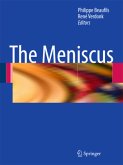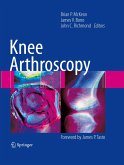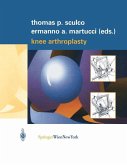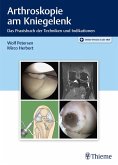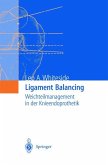The Knee Joint
Surgical Techniques and Strategies
Herausgegeben:Bonnin, Michel; Amendola, Ned Annunziato; Bellemans, Johan; MacDonald, Steven J.; Menetrey, Jacques
The Knee Joint
Surgical Techniques and Strategies
Herausgegeben:Bonnin, Michel; Amendola, Ned Annunziato; Bellemans, Johan; MacDonald, Steven J.; Menetrey, Jacques
- Gebundenes Buch
- Merkliste
- Auf die Merkliste
- Bewerten Bewerten
- Teilen
- Produkt teilen
- Produkterinnerung
- Produkterinnerung
Pushed by the progress of biology, technology and biomechanics, knee surgery has dramatically evolved in the last decades. This book is a "state of the art" concerning all aspects of knee surgery from ligament reconstruction to Total Knee Arthroplasty. An international panel of renowned authors have worked on this didactic fully illustrated book. It will help young surgeons to understand basic sciences and modern sugical techniques. The experienced surgeon will find help to deal with difficult cases and clarifications in recent technologic advances such as cartilage surgery, navigation and mini invasive surgery. …mehr
Andere Kunden interessierten sich auch für
![The Knee Joint The Knee Joint]() The Knee Joint164,99 €
The Knee Joint164,99 €![Knee Surgery Knee Surgery]() James StannardKnee Surgery137,99 €
James StannardKnee Surgery137,99 €![The Meniscus The Meniscus]() Philippe Beaufils / René Verdonk (Hrsg.)The Meniscus113,99 €
Philippe Beaufils / René Verdonk (Hrsg.)The Meniscus113,99 €![Knee Arthroscopy Knee Arthroscopy]() Knee Arthroscopy75,99 €
Knee Arthroscopy75,99 €![Knee Arthroplasty Knee Arthroplasty]() Thomas P. Sculco / Ermanno A. Martucci (eds.)Knee Arthroplasty77,99 €
Thomas P. Sculco / Ermanno A. Martucci (eds.)Knee Arthroplasty77,99 €![Arthroskopie am Kniegelenk Arthroskopie am Kniegelenk]() Wolf PetersenArthroskopie am Kniegelenk110,00 €
Wolf PetersenArthroskopie am Kniegelenk110,00 €![Ligament Balancing Ligament Balancing]() Leo A. WhitesideLigament Balancing119,99 €
Leo A. WhitesideLigament Balancing119,99 €-
-
-
Pushed by the progress of biology, technology and biomechanics, knee surgery has dramatically evolved in the last decades. This book is a "state of the art" concerning all aspects of knee surgery from ligament reconstruction to Total Knee Arthroplasty. An international panel of renowned authors have worked on this didactic fully illustrated book. It will help young surgeons to understand basic sciences and modern sugical techniques. The experienced surgeon will find help to deal with difficult cases and clarifications in recent technologic advances such as cartilage surgery, navigation and mini invasive surgery.
Hinweis: Dieser Artikel kann nur an eine deutsche Lieferadresse ausgeliefert werden.
Hinweis: Dieser Artikel kann nur an eine deutsche Lieferadresse ausgeliefert werden.
Produktdetails
- Produktdetails
- Verlag: Springer / Springer Paris / Springer, Berlin
- Artikelnr. des Verlages: 12692538, 978-2-287-99352-7
- 2011
- Seitenzahl: 1104
- Erscheinungstermin: 13. März 2012
- Englisch
- Abmessung: 276mm x 215mm x 64mm
- Gewicht: 2767g
- ISBN-13: 9782287993527
- ISBN-10: 2287993525
- Artikelnr.: 26852303
- Herstellerkennzeichnung
- Springer-Verlag GmbH
- Tiergartenstr. 17
- 69121 Heidelberg
- ProductSafety@springernature.com
- Verlag: Springer / Springer Paris / Springer, Berlin
- Artikelnr. des Verlages: 12692538, 978-2-287-99352-7
- 2011
- Seitenzahl: 1104
- Erscheinungstermin: 13. März 2012
- Englisch
- Abmessung: 276mm x 215mm x 64mm
- Gewicht: 2767g
- ISBN-13: 9782287993527
- ISBN-10: 2287993525
- Artikelnr.: 26852303
- Herstellerkennzeichnung
- Springer-Verlag GmbH
- Tiergartenstr. 17
- 69121 Heidelberg
- ProductSafety@springernature.com
The Traumatic Knee.- The menisci: anatomy, healing response, and biomechanics.- The cruciate ligaments: anatomy, biology, and biomechanics.- The anatomy and biomechanics of the medial collateral ligament and posteromedial corner of the knee.- The lateral collateral ligament and posterolateral corner.- Basic science of ligament healing.- Clinical basis: epidemiology, risk factors, mechanisms of injury, and prevention of ligament injuries of the knee.- MRI evaluation of knee ligaments.- Classification of knee laxities.- Scoring the knee.- The Menisci.- Arthroscopic meniscectomy.- Meniscal sutures.- Meniscal allograft transplantation.- The ACL.- Diagnostic and surgical decision ACL tears.- Natural history of ACL tears: from rupture to osteoarthritis.- Graft choice in ACL reconstruction.- Tunnels, graft positioning, and isometry in ACL reconstruction.- Technique in ACL reconstruction: hamstring reconstruction.- Technique in ACL reconstruction: patellar tendon.- Place of navigation in anterior cruciate ligament reconstruction.- Single or double bundle?.- Anatomic double-bundle ACL reconstruction: how I do it?.- Results of ACL reconstruction.- Arthrofi brosis after anterior cruciate ligament reconstruction.- ACL rehabilitation.- ACL rupture in children: anatomical and biological bases, outcome of ACL deficient knee in childhood: strategy, operative technique, results, and complications.- Combined injuries of the anterior cruciate ligament and posterolateral corner.- Failure in ACL reconstruction: etiology, treatment, and results.- The PCL.- Definition and diagnosis of posterior cruciate ligament injury and algorithm of treatment.- Natural history of PCL ruptures.- The PCL: different options in PCL reconstruction: choice of the graft? One or two bundles?.- Graft tunnel positioning during PCL reconstruction.- Techniques in posterior cruciate ligament reconstruction: an arthroscopic approach.- Arthroscopic reconstruction of the posterior cruciate ligament using double-bundle and tibial-inlay technique.- Technique in PCL reconstruction: mini posterior approach.- Results of PCL reconstruction.- Combined injuries to the posterior cruciate ligament and medial collateral ligament of the knee.- PCL injury associated with a posterolateral tear.- Bicruciate injuries and dislocations.- The multiple-ligament injured knee.- Surgical treatment of cartilage tear: principles and results.- Technique of mosaicplasty.- Allograft osteoarticular resurfacing.- Technique of chondrocytes implantation.- Regenerative medicine for cartilage.- Patello-femoral joint.- The biomechanics of the patella.- Imaging of patellofemoral joint.- Anterior knee pain and patellar instability: diagnosis and treatment.- Patellar stabilization for episodic patellar instability.- Deepening trochleoplasty for patellofemoral instability.- The Degenerative Knee.- Osteoarthritis of the patello-femoral joint.- Patellofemoral osteoarthritis: pathophysiologie, treatment and results.- Patellofemoral replacement.- Indications in osteoarthritis of the femoro-tibial joint.- Is there a place for arthroscopy in the degenerative knee?.- Surgical indications in medial knee osteoarthritis.- Osteotomy around the knee.- Biomechanics, basis, and indications of osteotomies around the knee.- Technique of closing wedge HTO.- Technique of open wedge HTO.- Results of HTO in medial OA of the knee.- Osteotomies in the valgus knee.- Medial closing wedge varus osteotomy of the distal femur.- Unicondylar knee arthroplasty.- Technical considerations, results, and complications of mobile-bearing UKA.- Fixed bearing unicompartmental knee prosthesis: results, complications, and technical considerations.- Indications of unicompartmental knee arthroplasty.- Lateral Unicompartmental Knee Replacement.- Primary Total Knee Arthroplasty.- Design and concept in TKA.- The history of total knee arthroplasty.- Posterostabilized TKA: advantages and disadvantages.- Conservation of posterior cruciate ligament in fixed-bearing total knee replacement.- Deep dish TKA: advantages and disadvantages.- Bicruciate retaining TKA: the future?.- Mobile-bearing total knee arthroplasty: advantages and disadvantages.- Fixed-bearing total knee arthoplasty: advantages and disadvantages.- Cement fixation for total knee arthroplasty.- Surgical techniques.- Pre-operative imaging techniques.- In primary total knee replacement: role for computed tomography.- The mini-subvastus approach for total knee arthroplasty.- The degenerative knee - surgical techniques: "gap balancing".- Component orientation and total knee arthroplasty.- Rotation of components in total knee arthroplasty.- Improving mobility.- Medical management before and after TKA.- Rehabilitation protocol following total knee arthroplasty.- The Patella in TKA.- Why I always resurface the patella in TKA.- Why I do not routinely resurface the patella in TKA.- Navigation in TKA.- Total knee replacement navigation: the different techniques.- Why using navigation in total knee arthroplasty?.- Results in Primary TKA.- Results and function of total knee arthroplasty.- Difficulties in Primary TKA.- TKA in the stiff knee.- The lateral approach in the valgus knee.- TKA in the severe valgus knee: lateral epicondyle sliding osteotomy technique.- Total knee replacement in patients with severe varus deformity.- Total knee arthroplasty after failed high tibial osteotomy.- Total knee arthroplasty after malunion.- Revision total knee arthroplasty after failed unicompartmental knee replacement.- Failures and Revision in TKA.- Causes of failures in TKA.- The painful total knee arthroplasty.- Pre-operative planning for revision TKA.- Technique of revision: surgical approach.- Revision TKA: component removal.- Management of bony defects in revision TKR.- Stems in revision TKA.- Technique of revision in TKA: joint line level.- Technique of revision in total knee arthroplasty: the patella.- Extensor mechanism allograft, surgical technique.- Infection in total knee arthroplasty, prevention.- Diagnosis of infection after total knee arthroplasty.- Infection in total knee arthroplasty: treatment.
The Traumatic Knee.- The menisci: anatomy, healing response, and biomechanics.- The cruciate ligaments: anatomy, biology, and biomechanics.- The anatomy and biomechanics of the medial collateral ligament and posteromedial corner of the knee.- The lateral collateral ligament and posterolateral corner.- Basic science of ligament healing.- Clinical basis: epidemiology, risk factors, mechanisms of injury, and prevention of ligament injuries of the knee.- MRI evaluation of knee ligaments.- Classification of knee laxities.- Scoring the knee.- The Menisci.- Arthroscopic meniscectomy.- Meniscal sutures.- Meniscal allograft transplantation.- The ACL.- Diagnostic and surgical decision ACL tears.- Natural history of ACL tears: from rupture to osteoarthritis.- Graft choice in ACL reconstruction.- Tunnels, graft positioning, and isometry in ACL reconstruction.- Technique in ACL reconstruction: hamstring reconstruction.- Technique in ACL reconstruction: patellar tendon.- Place of navigation in anterior cruciate ligament reconstruction.- Single or double bundle?.- Anatomic double-bundle ACL reconstruction: how I do it?.- Results of ACL reconstruction.- Arthrofi brosis after anterior cruciate ligament reconstruction.- ACL rehabilitation.- ACL rupture in children: anatomical and biological bases, outcome of ACL deficient knee in childhood: strategy, operative technique, results, and complications.- Combined injuries of the anterior cruciate ligament and posterolateral corner.- Failure in ACL reconstruction: etiology, treatment, and results.- The PCL.- Definition and diagnosis of posterior cruciate ligament injury and algorithm of treatment.- Natural history of PCL ruptures.- The PCL: different options in PCL reconstruction: choice of the graft? One or two bundles?.- Graft tunnel positioning during PCL reconstruction.- Techniques in posterior cruciate ligament reconstruction: an arthroscopic approach.- Arthroscopic reconstruction of the posterior cruciate ligament using double-bundle and tibial-inlay technique.- Technique in PCL reconstruction: mini posterior approach.- Results of PCL reconstruction.- Combined injuries to the posterior cruciate ligament and medial collateral ligament of the knee.- PCL injury associated with a posterolateral tear.- Bicruciate injuries and dislocations.- The multiple-ligament injured knee.- Surgical treatment of cartilage tear: principles and results.- Technique of mosaicplasty.- Allograft osteoarticular resurfacing.- Technique of chondrocytes implantation.- Regenerative medicine for cartilage.- Patello-femoral joint.- The biomechanics of the patella.- Imaging of patellofemoral joint.- Anterior knee pain and patellar instability: diagnosis and treatment.- Patellar stabilization for episodic patellar instability.- Deepening trochleoplasty for patellofemoral instability.- The Degenerative Knee.- Osteoarthritis of the patello-femoral joint.- Patellofemoral osteoarthritis: pathophysiologie, treatment and results.- Patellofemoral replacement.- Indications in osteoarthritis of the femoro-tibial joint.- Is there a place for arthroscopy in the degenerative knee?.- Surgical indications in medial knee osteoarthritis.- Osteotomy around the knee.- Biomechanics, basis, and indications of osteotomies around the knee.- Technique of closing wedge HTO.- Technique of open wedge HTO.- Results of HTO in medial OA of the knee.- Osteotomies in the valgus knee.- Medial closing wedge varus osteotomy of the distal femur.- Unicondylar knee arthroplasty.- Technical considerations, results, and complications of mobile-bearing UKA.- Fixed bearing unicompartmental knee prosthesis: results, complications, and technical considerations.- Indications of unicompartmental knee arthroplasty.- Lateral Unicompartmental Knee Replacement.- Primary Total Knee Arthroplasty.- Design and concept in TKA.- The history of total knee arthroplasty.- Posterostabilized TKA: advantages and disadvantages.- Conservation of posterior cruciate ligament in fixed-bearing total knee replacement.- Deep dish TKA: advantages and disadvantages.- Bicruciate retaining TKA: the future?.- Mobile-bearing total knee arthroplasty: advantages and disadvantages.- Fixed-bearing total knee arthoplasty: advantages and disadvantages.- Cement fixation for total knee arthroplasty.- Surgical techniques.- Pre-operative imaging techniques.- In primary total knee replacement: role for computed tomography.- The mini-subvastus approach for total knee arthroplasty.- The degenerative knee - surgical techniques: "gap balancing".- Component orientation and total knee arthroplasty.- Rotation of components in total knee arthroplasty.- Improving mobility.- Medical management before and after TKA.- Rehabilitation protocol following total knee arthroplasty.- The Patella in TKA.- Why I always resurface the patella in TKA.- Why I do not routinely resurface the patella in TKA.- Navigation in TKA.- Total knee replacement navigation: the different techniques.- Why using navigation in total knee arthroplasty?.- Results in Primary TKA.- Results and function of total knee arthroplasty.- Difficulties in Primary TKA.- TKA in the stiff knee.- The lateral approach in the valgus knee.- TKA in the severe valgus knee: lateral epicondyle sliding osteotomy technique.- Total knee replacement in patients with severe varus deformity.- Total knee arthroplasty after failed high tibial osteotomy.- Total knee arthroplasty after malunion.- Revision total knee arthroplasty after failed unicompartmental knee replacement.- Failures and Revision in TKA.- Causes of failures in TKA.- The painful total knee arthroplasty.- Pre-operative planning for revision TKA.- Technique of revision: surgical approach.- Revision TKA: component removal.- Management of bony defects in revision TKR.- Stems in revision TKA.- Technique of revision in TKA: joint line level.- Technique of revision in total knee arthroplasty: the patella.- Extensor mechanism allograft, surgical technique.- Infection in total knee arthroplasty, prevention.- Diagnosis of infection after total knee arthroplasty.- Infection in total knee arthroplasty: treatment.
Aus den Rezensionen:
"... Natürlich ist das Buch vom SpringerVerlag hervorragend ausgestattet: Tabellen, Algorithmen und Abbildungen entsprechen hochsten didaktischen Anforderungen ... jeder Aspekt der Kniegelenksendoprothetik werden sehr ausführlich dargestellt. ... die umfangreichen Revisionsprobleme werden in diesem Buch auf einem sehr hohen Standard dargestellt. Fur den Kniespezialisten ein unverzichtbares Buch, dass das aktuelle Wissen uber das Knie ... zusammenfasst und in jede Bibliothek gehört, wenn man sich mit dem Thema Knie auf einem hohen Niveau beschäftigen möchte." ( W Siebert, in: OUP Orthopädische und Unfallchirgurgischee Praxis, 2012, Vol. 1, Issue. 9, S.369)
"... Natürlich ist das Buch vom SpringerVerlag hervorragend ausgestattet: Tabellen, Algorithmen und Abbildungen entsprechen hochsten didaktischen Anforderungen ... jeder Aspekt der Kniegelenksendoprothetik werden sehr ausführlich dargestellt. ... die umfangreichen Revisionsprobleme werden in diesem Buch auf einem sehr hohen Standard dargestellt. Fur den Kniespezialisten ein unverzichtbares Buch, dass das aktuelle Wissen uber das Knie ... zusammenfasst und in jede Bibliothek gehört, wenn man sich mit dem Thema Knie auf einem hohen Niveau beschäftigen möchte." ( W Siebert, in: OUP Orthopädische und Unfallchirgurgischee Praxis, 2012, Vol. 1, Issue. 9, S.369)

